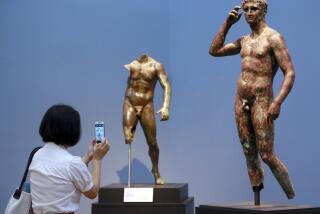Bernini bust at Getty Museum prompts criminal complaint in Slovakia
- Share via
When the J. Paul Getty Museum announced in June the purchase of a 17th century bust by Gian Lorenzo Bernini, it was heralded as a major acquisition -- the first sculpture attributed solely to the Italian Baroque genius in the museum’s collection.
But now a criminal complaint has been filed in Slovakia in connection with the sale of the sculpture, in which the country’s cultural minister claims improprieties in the piece’s rather convoluted journey.
No one has alleged that the Getty Museum has done anything wrong by acquiring the marble bust, which is an early Bernini work that depicts Pope Paul V. The Los Angeles museum said it acquired the piece earlier this year in a private sale through Sotheby’s in London.
SIGN UP for the free Essential Arts & Culture newsletter >>
Instead, Slovakia’s cultural minister, Marek Madaric, has filed a criminal complaint against an unnamed individual, prompting questions about why a Slovakian auction house may have misvalued the Bernini bust, thereby resulting in the country’s loss of a historic artwork.
A spokesman for the minister confirmed in an email that a complaint has been filed against “an unknown offender, suspecting that the persons who participated in the statue’s sales process could have known the value of this artwork.”
The spokesman didn’t identify the offender, though he added that the individual who appraised the piece may have violated certain rules. He didn’t elaborate.
The SOGA auction house in Bratislava has stated on its website that it first attempted to sell the piece in December 2013 as part of a sale of an estate by the late Slovakian artist Ernest Zmeták. But the auction house listed the piece as a work by an unknown Italian sculptor with a minimum selling price of 47,000 euros (about $52,000). The piece failed to sell.
The following year, SOGA again failed to sell the item when it was put up for auction. Later, a collector named Clément Guenebeaud acquired the marble for just 24,000 euros, according to the Tyzden, a Slovakian journal.
From there, Guenebeaud attempted to sell the work, but questions about its provenance made that difficult. The bust had disappeared from public view for much of the 20th century, prompting concerns that it might have been looted at some point, possibly by the Nazis.
The Tyzden reported that the bust eventually received a license for export after its acquisition by Guenebeaud. Later, Sotheby’s became involved with the artwork, though how exactly remains unclear.
It also remains unclear at what point the bust was re-attributed to Bernini.
Some reports have said the Getty Museum acquired the Bernini for $33 million. A spokeswoman for the Getty said the museum doesn’t comment on the price of objects it acquires.
The Bernini bust was completed in 1621 as a commission from Cardinal Scipione Borghese, a nephew of the papal leader who would become one of the artist’s most important patrons. It belonged for centuries to the family until it was sold at auction in 1893 to a private Viennese collector.
From there, its whereabouts were unknown to the public until it surfaced at the SOGA auction in 2013.
The Bernini bust is on view at the Getty Center in Brentwood.
Twitter: @DavidNgLAT
MORE:
Review: Bronze sculptures in ‘Power and Pathos’ at the Getty capture pivotal era
The paradox of ‘Power and Pathos’ at the Getty: Disasters rescued these ancient bronzes
Editorial: Sorry, Italy, the ‘Getty Bronze’ belongs in L.A.
More to Read
The biggest entertainment stories
Get our big stories about Hollywood, film, television, music, arts, culture and more right in your inbox as soon as they publish.
You may occasionally receive promotional content from the Los Angeles Times.











